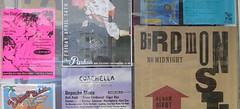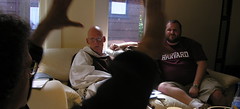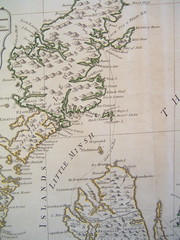The Invisible Frontier: Thrivability Essay, 2010
(the following essay was my contribution to Jean Russell's digital pamphlet, Thrivability, which outlines the pathways to a new economy built upon respect for humans, the value economy, and the environment. Read more about Jean's vision at her blog, Thrivable)
The invisible frontier is the location of the zones where modernity has failed to make good on its promises: famines, wars, corrupt bureaucracies; ghettos without exits. For those who rest content in the faith that capital heals everything, the invisible frontier remains invisible. When confronted with rumors of people on the other side, they characterize those people as monsters : the great unwashed, living in a devil’s playground of arson and gang wars.
The old-fashioned capitalists are wrong about what things look like across the invisible frontier. That way lies information, precious information. The information tells us about modernity’s failures, about government abuses and neglect, about disintegrating markets. A drive through the wrong side of town shows the grocery stores that are closing their doors, the encampments of homeless, the empty factories.
A drive through the Rust Belt shows quick the devastation hidden from coastal enclaves: entire neighborhoods, demolished. Standing skyscrapers, vacant. New empty lots, cleared by arson. Closing schools. Closing hospitals. Abandoned old folks’ homes. No one can afford them. This information is frequently of a kind useful to those who care about the future: it shows how bad the economy is and how much worse it could get. The invisible frontiers show what happens in the breakdown of capitalism and government: they show the societies of hobos, the existence of spontaneous guilds in trailer parks, child-care co-ops, community gardens, and utopian storefronts. The
invisible frontier is the location of experiments that rival capitalism.
In general, invisibility happens because of lack of access to capital, social or otherwise. The son-of-a-preacher public health expert hasn’t walked the back roads of Liverpool and has preconceptions about what the inhabitants need: they need morality before they need running water. The son-of-a-preacher knows who to talk to in parliament; the Liverpudlians do not. Another example: the health-insurance lobbyist
can buy access to the Senator; devoted student activists cannot. People on the other side of the digital divide -- the 12% whom the Pew tells us have not even a dial-up connection -- cannot tell Silicon-Valley engineers to design community-participation software that runs off of cell phones.
Insidiously, however, the invisibility of people is usually mutual. Even if you volunteered to design infrastructure tailored to the people on the other side of the digital divide, they might have a hard time answering the question. The uses of infrastructure are new to a people who lost their houses to highways. Poor factory-workers in nineteenth-century Liverpool choked when they went to Parliament.
They didn’t know which functionary they would speak to, or which language with which they would interact if they found him. A whole host of functionaries have arisen since 1870 with the attention of bridging these gaps: public schools, social workers, outreach centers, organizers, and activists. All of our modern institutions produce a
surfeit of paper. The institutions of freedom -- from Parliament and Congress to the school board to the IRS and the design of the internet -- are shrouded in paper, their inner workings invisible to the people who would benefit the most therefrom.
Landscape invisibility compounds class invisibility. Stockton, a foreclosure capital, is home to Hispanic truck-drivers and factory-workers who have lost their houses in great numbers. They are no different than other, better-known working-class immigrants in San Diego, Chicago, and New York. However, Stockton is off the map. First, the poor lose their landscape; next, they become invisible. Whatever capital has forgotten about dissolves like the soft paper of midcentury paperbacks, crumbling in the hand. On the digital landscape, the overworked and harried rarely contribute to community web2.0 bike-maps. They too become invisible. We keep planning, however, as if there were no frontier, and nothing invisible beyond it.
The truly sustainable, the thrivable designer, reaches hands across the invisible frontier. It reaches across the digital divide, and puts technology for rethinking government, energy, and food directly in the hands of those communities who live in food ghettos (where there are no grocery stores) and dial-up deserts (where one pays
upwards of $40/mo for a slow connection on a pc shared by 5). Thrivable design listens patiently, it enters dialogue with potential users who find the new terms difficult, whose interests and resources and foreign to those who come from a state of capital.
Thrivability recasts the designer's place: no more in the halls of power, hanging out in shiny buildings in well-kept cafes with others of money; now instead, the designer belongs in the city, on public transit, exploring the suburban ghetto. Thrivable design on the invisible frontier pays attention to all those details of life hidden in the landscape -- the public places where strangers meet, the memory of people who have migrated a long way together, the corridors people travel who don't have access to funds.
The thrivable designer sees life -- people trying to make a living, communities that need tools -- where old-fashioned capitalists see only failure. Thrivability recasts the designer's role: no more the paid lieutenant of corporation and state; now, instead, the wanderer around invisible peripheries, the witness and facilitator of emergent states.
Labels: design, Digital divide, geography, invisibility, landscape, modernity, Silicon Valley, thrivability, web 2.0
![Reblog this post [with Zemanta]](http://img.zemanta.com/reblog_e.png?x-id=17d8bc4d-339c-414b-b04c-b33245ad7a31)






![Reblog this post [with Zemanta]](http://img.zemanta.com/reblog_e.png?x-id=0234c36f-640d-48bf-bbda-e228a4d13b7d)









